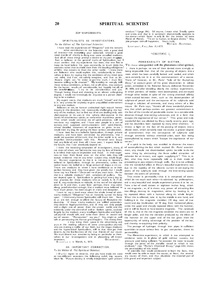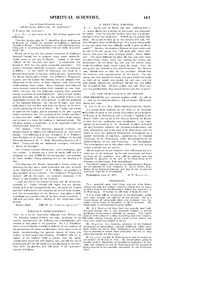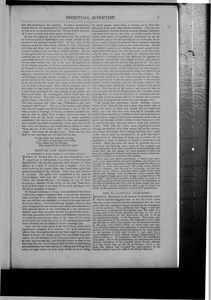
Legend
< Deserved Compliments (continued from page 3-146) >
In conclusion, we again urge our readers, one and all, not to fail to obtain an insight into Col. Olcott’s work, by far the most astonishing the nineteenth century has yet produced.
Permeability of Matter
To those unacquainted with the phenomena called spiritual, there is perhaps no one of them denied more strongly as being impossible than that of the passing of objects into a room which has been carefully locked and sealed, and which were certainly not in it at the commencement of a seance. There is however, in Dr. Paris' “Life of Sir Humphrey Davy,” an account given of his great discoveries in voltaic action, embodied in his Bakerian lecture, delivered November 20, 1806, and after detailing clearly the various experiments, in which portions of bodies were decomposed, and conveyed through other bodies in spite of the strong chemical affinity which existed between them, such as the decomposition of sulphate of potash and the conveyance of its sulphuric acid through a solution of ammonia, and many others of a like nature Dr. Paris says, “Amidst all these wonderful phenomena, that which perhaps excites our greatest astonishment is the fact of the transfer of ponderable matter to a considerable distance through intervening substances, and in a form that escapes the cognizance of our senses.” This great and truly wonderful fact was elicited by Davy nearly seventy years ago, and has doubtless been repeated by many other chemists. It throws a light on the fact of the passing of objects into a closed room, which certainly need not excite a greater degree of astonishment than the conveyance of sulphuric acid through ammonia without chemical union, each fact being accomplished by means which “escape the cognizance of our senses.”
If a spirit in the body was enabled to discover the means of accomplishing the fact which excited Dr. Paris' astonishment, why should not disembodied spirits be able to do the same thing by abstracting the force called attraction of cohesion for an instant, and again supplying it? This is, in fact, what they have repeatedly told us is their mode of proceeding to pass objects through walls. But it is not unlikely that the wonderful effect in Davy’s beautiful experiments was due to the rapidity of the electric current in conveying the atoms of the sulphuric acid through the intervening spaces between the atoms of ammonia.
That matter is permeable, —that it is composed of atoms which do not touch each other—is admitted by philosophers, and a very beautiful and simple experiment proves it to be so. Take a bar of steel, sixteen or eighteen inches long, which is not magnetic; or, if it shows any power of attracting fine iron filings, destroy its magnetism, either by heating it, or by repeated blows with a hammer along its whole length. When this is effected, take it by the middle in one hand, and holding it in the magnetic meridian (19 deg. west of true north) and dip (inclination of 70 deg. from horizontal plane), strike the upper end sharply repeated blows with the hammer, and it will be found to have become magnetic. The rationale of this is, that in the non-magnetic condition the atoms are no longer polar, and that the vibration produced by the blows of the hammer on the upper end of the bar gives them the opportunity of taking advantage of the position of the bar, and thereby re-acquiring their polarity.
The passage of hydrogen through iron pipes in sufficient quantities to cause serious loss to gas companies, shows its permeability.
The Florentine experiment, in which it was attempted to condense water in a globe of gold without success, but pressure used being sufficient “to occasion the water to exude through the pores of the metallic vessel in which it was enclosed,” (see “Parke’s Chemical Essay,” page 424) shows the permeability of this metal.
If scientific men would condescend to learn the facts, they would soon be able to teach the causes, at least, the secondary causes of them, and thus elucidate the material part of this grand and important subject.
An Important Correction
To the Editor of The Spiritual Scientist.
I deeply regret to observe, that you have made me state on two different occasions the following awful, big, square, black lie. “Future destiny is wholly independent upon present conduct.’’! (page 194). Of course, I mean what I really spoke and wrote, and that is a sentiment diametrically opposite to the above—which latter is only fit for the bosom of some Fiend of Fiends. “To err is human, to forgive divine.” May you prosper with all happiness. Yours truly,
Liverpool, Eng., Jan. 15, 1875.
A Beautiful Parable
A rich young man of Rome had been suffering from a severe illness, but at length he was cured, and recovered his health. Then he went for the first time into the garden and felt as if he was newly born. Full of joy, he praised God aloud. He turned his face up to the heavens and said, “Oh thou Almighty Giver of all blessings, if a human being could in any way repay thee, how willingly would l give up all my wealth!” Hermes, the shepherd, listened to these words, and he said to the rich young man, “All good gifts come from above; thou canst not send anything thither. Come, follow me.” The youth followed the pious old man, and they came to a dark hovel, where there was nothing but misery and lamentation; for the father lay sick, and the mother wept, while the children stood round crying for bread. Then the young man was shocked at the scene of distress. But Hermes said, “Behold here an altar for thy sacrifice! Behold here the brethren and representatives of the Lord! The rich young man then opened his hands, and gave freely and richly to them of his wealth, and tended the sick man; and the poor people, relieved and comforted, blessed him and called him an angel of God. Hermes smiled, and said, “Ever thus turn thy grateful looks first toward heaven and then to earth.”
To the Spiritualists of Boston
The following, just received, explains itself. As will be seen by the editorial columns full particulars will be published next week.
E. Gerry Brown, Esq., Editor, Spiritual Scientist, Boston.
In a private letter received by me from A. N. Aksakoff, Counselor of State in the private Chancellery of the Emperor of Russia, at St. Petersburg, and a circular—“Appeal to Mediums”—both sent by me to the Consul-General of Russia in New York for verification and certification, I, the undersigned, am entrusted by A. N. Aksakoff to select several of the best American mediums for physical manifestations and other phenomena, and invite them to St. Petersburg, with the object to have the Spiritual Phenomena investigated by a special committee of scientists, appointed by the Imperial University of St. Petersburg, under the presidency of the Chief Professor of the said University, D. I. Mendeleyeff. The investigations are to take place twice a week and during no less a period than six months.
All the expenses of the mediums who will accept the invitation are to be defrayed by the said committee, and terms by those of the mediums, who will be selected here and accepted as genuine, to be sent to St. Petersburg, to the President of Committee, Professor Mendeleyeff.
Therefore, I appoint and name as my sole deputy at Boston, for the selection of such mediums, E. Gerry Brown, Esq., Editor of the Spiritual Scientist, and beg of him to take the necessary steps for it immediately.
Philadelphia, June 22, 1875.
Key to Egyptian Astronomy
Proffessor Mitchell, in his lectures on astronomy, stated that he had not long since met, in the city of St Louts, Missouri, a man of great scientific attainments who, for forty years, had been engaged in Egypt deciphering the hieroglyphics of the ancients. This gentleman had stated to him that he had lately unravelled the inscriptions upon the coffin of a mummy, now in the British Museum, and that, by the aid of previous observation, he had discovered the key to all the astronomical knowledge of the Egyptians. The zodiac, with the exact position of the planets, was delineated on the coffin, and the date to which they pointed was the autumnal equinox in the year 1723 before Christ, or nearly 3,600 years ago. Prof. Mitchell employed his assistants to ascertain the exact position of the heavenly bodies belonging to our solar system on the equinox of that year (1722 B. C.), and send him a correct diagram of them, without having communicated his object in doing so. In compliance with this the calculations were made; and to his astonishment, on comparing the result with the statements of his scientific friend already referred to, it was found that, on the 7th of October, 1722 B. C., the moon and planets had occupied the exact position in the heavens marked upon the coffin in the British Museum.
Editor's notes
- ↑ Permeability of Matter by unknown author, Spiritual Scientist, v. 2, No. 2, March 18, 1875, p. 20
- ↑ An Important Correction by Hitchman, William, Spiritual Scientist, v. 2, No. 2, March 18, 1875, p. 20
- ↑ A Beautiful Parable by unknown author, Spiritual Scientist, v. 2, No. 16, June 24, 1875, p. 183
- ↑ To the Spiritualists of Boston by Blavatsky, H. P., Spiritual Scientist, Boston, Vol. II, June 24, 1875, p. 183
- ↑ Key to Egyptian Astronomy by unknown author, Spiritual Scientist, v. 2, No. 1, March 11, 1875, p. 9
Sources
-
Spiritual Scientist, v. 2, No. 2, March 18, 1875, p. 20
-
Spiritual Scientist, v. 2, No. 16, June 24, 1875, p. 183
-
Spiritual Scientist, v. 2, No. 1, March 11, 1875, p. 9


